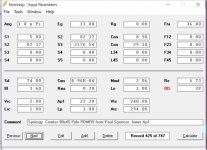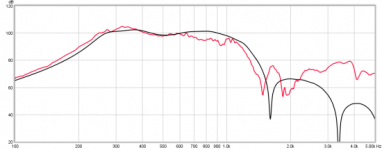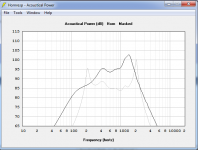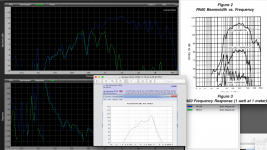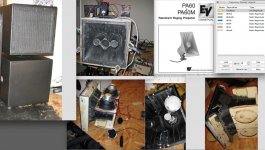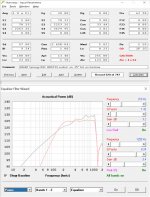For the record, here are the Pyle params that I snooped from Paul's blog. There is more and good history on the 4" Celestion sealed back mids, if you can find them albeit higher cost. their TSP's from BWaslo attached. the sim vs measured picture I also poached from the Internet on the pyles (middle attachment) looks pretty good. 5" vs 4" might make a difference
Attachments
Interesting! Here's the Pyle's specs from fluid's link: Red Spade Audio: Point source horn driver selection
Will the real PDMR5 please stand up! 😉
GM
Will the real PDMR5 please stand up! 😉
GM
The response shape is largely determined by the bandpass chamber and port. What matters is smoothness and headroom within that shape
For the record, here are the Pyle params that I snooped from Paul's blog. There is more and good history on the 4" Celestion sealed back mids, if you can find them albeit higher cost. their TSP's from BWaslo attached. the sim vs measured picture I also poached from the Internet on the pyles (middle attachment) looks pretty good. 5" vs 4" might make a difference
Please note a few things about these mids:
1) Tom Danley made a comment on diyaudio that I misinterpreted, which led to the notion that the Celestion mids are used in the Danley SH-50. This notion of mine was incorrect; the SH-50 and the Lambda Unity Horn both use the same closed back midrange, and it's *not* the Celestion. As I now understand it, the Celestion was used on a few of the Danley horns where the Misco unit wouldn't work.
2) While the Pyle sealed back midrange will work, I don't think it's ideal. QES isn't as high as I'd like.
Basically if you're going to go with a sealed back midrange, you probably want to make a call to Misco and buy a box of theirs. They're not expensive, I paid something like $150 for a case of eight. They're built to order so it takes a couple of weeks.
"QES isn't as high as I'd like." you mean as low? this PYLE driver seems to have a very weak motor I'm going off it now I see the T/S params.
hmm, not much point in using rubbish drivers, any thoughts about the 4NDF34?
4NDF34 LF Drivers - B&C Speakers
Perhaps only two would be sufficient to match the distortion limit of a 1" throat comp.
4NDF34 LF Drivers - B&C Speakers
Perhaps only two would be sufficient to match the distortion limit of a 1" throat comp.
The B&C driver is about the same price as the Celestion 4" driver which worked quite well for me.
I think 2 per horn would be fine for home use but used 4 per horn anyway as I bought 12 at the beginning of my project to have enough for a set of 3 for home cinema.
Rob.
I think 2 per horn would be fine for home use but used 4 per horn anyway as I bought 12 at the beginning of my project to have enough for a set of 3 for home cinema.
Rob.
I performed a quick sim of the B&C (black) and the Pyle (Grey) on an OD horn at the throat with very small throat chamber (to try and maximize bandwidth). This kind of exaggerated the trends that I saw with actually realizable designs where the B&C had more high frequency sensitivity (upto 4 dB) and a smoother response. As the rear chamber can be larger on the B&C it also looks possible to go lower.
The design of speaker I'm considering is a high output but very compact box using the B-52 waveguide, it might just be possible to do it as a two way though using a 10" driver.
The design of speaker I'm considering is a high output but very compact box using the B-52 waveguide, it might just be possible to do it as a two way though using a 10" driver.
Attachments

Here's some food for thought.
Here's a sim I made, of the B52 waveguide with four of the Fountek FE85. The Fountek's parameters are just about perfect for a Unity horn.
There are a bunch of 3" drivers out there, but most of them don't have a lot of motor strength, and so they wind up having an FS that's too low and a QES that's too high.

The Fountek is basically ALL MOTOR. The diaphragm is about the thinnest aluminum I've seen on a loudspeaker. So these leads to a unusually high FS and low QES for a woofer of this size. SB Audience sells some drivers that are even better, but they's 15X as expensive.
The graph that I've posted shows two traces. The black trace is unfiltered. In this configuration, you would need to keep the power very low, because the midranges will exceed xmax with more than about 10 watts. But you could probably squeeze about 200Hz to 20khz out of this setup.
The red trace is with a simple second order high pass. In this configuration, you could easily hit 115dB as long as the voice coils don't go up in smoke. The posted graph is with 100 watts, but once you add a filter you can pour even more power than that. (This is because the 'knee' of the filter is quite high, because the low frequency response is rising.)
Either one is viable, just depends on if you want a REALLY loud speaker with a complex crossover, or a low power speaker that won't be as bulletproof, due to the higher excursion.
Another big limiter on this particular setup, is that it's nearly impossible to make the back chamber small enough. The model that I've posted has the speaker in a box that's 0.375 liters each. That's a cube measuring 3" x 3" x 3." And this speaker is 3.5" in diameter, so obviously getting the box small enough is a bit of a challenge! I figure that you could build a box measuring about 4" x 4" x 4" and the volume of the driver itself will reduce the box volume to a point where you could get close to these predicted results.
hmm, not much point in using rubbish drivers, any thoughts about the 4NDF34?
4NDF34 LF Drivers - B&C Speakers
Perhaps only two would be sufficient to match the distortion limit of a 1" throat comp.
The specs on this driver are so far out, it almost seems too good to be true. I've seen lots of 8" and 12" drivers with this kind of motor strength, but nothing like this in a driver this size.
2 * FS / QES is the magic number, and for the 4NDF34 that's 786Hz. Just unbelievably high.
I took four of these and I simulated it on that B52 waveguide. But I added two inches to the depth. So instead of being 5.5" deep, the waveguide is 7.5" deep. Which is still very VERY compact. The mouth measured 18" x 13". We're talking about a footprint that's about as large as a JBL M2.
When I did that, the efficiency was a hundred and five dB!!! To put that in perspective, the JBL M2 has an efficiency of 92dB and the Danley SH-50 has an efficiency of 100dB. Of course, I'm not sure where you'll find a tweeter that could keep up with that. My Eminence N151Ms are the loudest tweeters I own, and they can produce 127dB at 5khz.
In a nutshell, the 4NDF34 is a beast, but I'm not 100% convinced that it's specs are even possible! If one built a Unity horn with that midrange, the tweeter would become the weak link in a hurry.
Excellent, 4 of them should do nicely then.
I have had success in the past sealing drivers by building up paper mache on the back of the basket and then covering that with construction adhesive. This takes about a week though of messy work as you have to build up layers so I won't be using this method in the future.
I have had success in the past sealing drivers by building up paper mache on the back of the basket and then covering that with construction adhesive. This takes about a week though of messy work as you have to build up layers so I won't be using this method in the future.
From what I've heard and measured, I like the BC 4NDF34 a lot.hmm, not much point in using rubbish drivers, any thoughts about the 4NDF34?
4NDF34 LF Drivers - B&C Speakers
Perhaps only two would be sufficient to match the distortion limit of a 1" throat comp.
Using four of them driving a dual EV PA60 horn, with a LeSon piezo tweeter to sizzle above 6kHz, the exterior box size is a cube a fraction over one foot about 28 liters. The measurement below shows the response with a passive crossover in blue, the 4NDF34 only in green. I'd estimate the "0" line to be around 100 dB one watt one meter, not too different from your sim.
I had planned to cross over in the 450-500 Hz range, but ended up moving the crossover to just under 1kHz, as even when driven hard in the 100 Hz range, the 4NDF34 sounded much cleaner in the 500 Hz to 1kHz octave than the PA60.
Still have yet to crank the cabinet up outside, but I'd expect it to be able to swing an easy 130dB in the speech range.
Art
Attachments
Art put me on to the 4nDF34 a while ago with a post about it. I simmed it on the Synergy I had already built and it made me regret having chosen 4FE35s instead. These are clearly more robust but 4 of either of them were way overkill for home use so the choice really didn't matter.
The sim below has a 150 Hz highpass for XO to a woofer and hits the SPL at 2.2 mm excursion. At more reasonable output level it could go a bit lower.
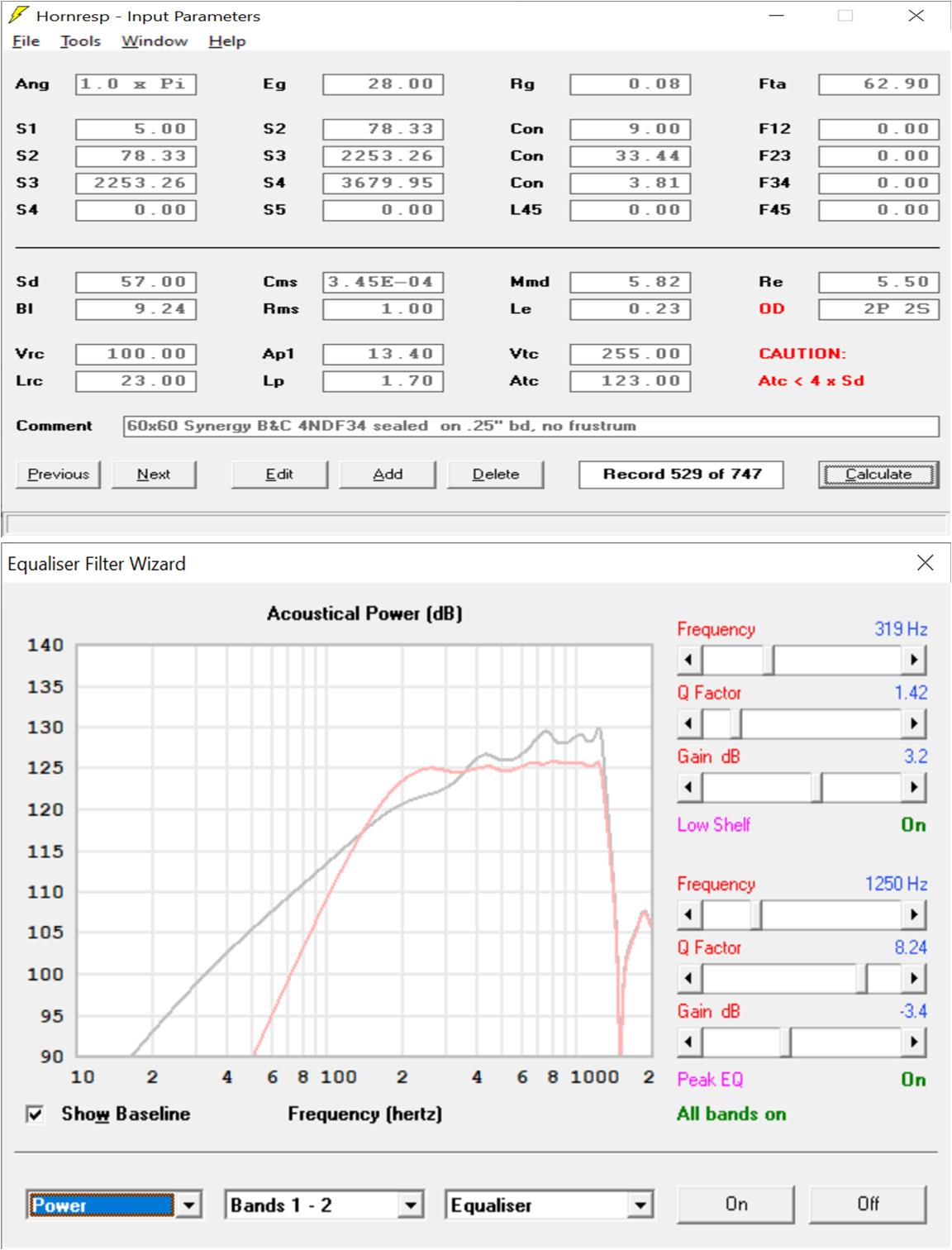
The sim below has a 150 Hz highpass for XO to a woofer and hits the SPL at 2.2 mm excursion. At more reasonable output level it could go a bit lower.
Attachments
Has anyone tried adding a secondary flare to the B-52/QSC/WG35 waveguide ? I have a bunch of these and would like to integrate them into a HT Synergy that has a mouth about 34" x 24". There is no way I can produce my own primary section as smooth as this horn.
Maybe I should broaden the question, does anyone know of examples of adding a secondary flare to any commercially produced horn/waveguide?
The PA60 horn is one crazy project! 125dB would be sufficient I think as the B-52 horn wide dispersion so any 1" throat comp is going to be on the verge of death at that point.
Adding a new secondary flare to the B-52 seems problematic without truncating the horn before the mouth round-over.
Adding a new secondary flare to the B-52 seems problematic without truncating the horn before the mouth round-over.
I think it can be done by mounting the waveguide from the back of the secondary waveguide flair and applying a small amount of fill at the junction. The flair at the mouth of the B-52 is quite rapid and the secondary flair would be pretty shallow.
For years, Parts Express has sold a dome midrange that's a nice match for a Unity horn.
Unfortunately, the PE midrange really needs some mods to make it work. In particular, the back chamber is too big, and this limits your output on a Unity horn.
Basically, if you're willing to cut the driver in half with a hacksaw, you can raise your efficiency (and output) a few dB.
Which is all well and good, but most people don't want to do this:
So it came as a pleasant surprise when I stumbled across a dome midrange from Samsung that JBL and Infinity are selling for car audio.
I've attached some pics. I hate to be hyperbolic, but this thing is REALLY hard to beat:
1) It is much more readily available than the Celestion or Misco midranges. Misco doesn't even list the JC5RTF-B on their website any longer. You can get the JBL and the Infinity from Amazon or eBay.
2) A Unity horn typically "wants" a midrange with an Fb of about 500Hz or a little higher. The JBL and Infinity mids fit the bill.
3) The JBL and Infinity mids may have higher output, because their power handling is higher, due to a larger voice coil. The Celestion TF0410MR has 30 watts of power handling, the Infinity has 65W.
4) For a Unity horn, you really want a rigid cone. The high compression of horn loading can destroy a soft dome midrange or tweeter.
5) One issue with a lot of small midranges is that the surround can get trashed from horn loading. Basically if you don't leave enough space, the surround will crack. (Ask me how I know...) But the JBL and Infinity have a fairly modest surround, which is GOOD for this application.
Anyways, have fun with this. You can find them on eBay as the JBL Stadium GTO 20M ($160) and on Amazon as the Infinity Kappa-20MX ($120.)
Unless I'm missing something, these two seem to be identical, but with different cosmetics.
Unfortunately, the PE midrange really needs some mods to make it work. In particular, the back chamber is too big, and this limits your output on a Unity horn.
Basically, if you're willing to cut the driver in half with a hacksaw, you can raise your efficiency (and output) a few dB.
Which is all well and good, but most people don't want to do this:
So it came as a pleasant surprise when I stumbled across a dome midrange from Samsung that JBL and Infinity are selling for car audio.
I've attached some pics. I hate to be hyperbolic, but this thing is REALLY hard to beat:
1) It is much more readily available than the Celestion or Misco midranges. Misco doesn't even list the JC5RTF-B on their website any longer. You can get the JBL and the Infinity from Amazon or eBay.
2) A Unity horn typically "wants" a midrange with an Fb of about 500Hz or a little higher. The JBL and Infinity mids fit the bill.
3) The JBL and Infinity mids may have higher output, because their power handling is higher, due to a larger voice coil. The Celestion TF0410MR has 30 watts of power handling, the Infinity has 65W.
4) For a Unity horn, you really want a rigid cone. The high compression of horn loading can destroy a soft dome midrange or tweeter.
5) One issue with a lot of small midranges is that the surround can get trashed from horn loading. Basically if you don't leave enough space, the surround will crack. (Ask me how I know...) But the JBL and Infinity have a fairly modest surround, which is GOOD for this application.
Anyways, have fun with this. You can find them on eBay as the JBL Stadium GTO 20M ($160) and on Amazon as the Infinity Kappa-20MX ($120.)
Unless I'm missing something, these two seem to be identical, but with different cosmetics.
Attachments
-
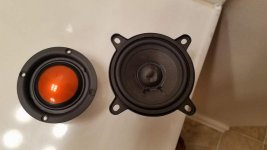 FB_IMG_1511109593267.jpg25.5 KB · Views: 445
FB_IMG_1511109593267.jpg25.5 KB · Views: 445 -
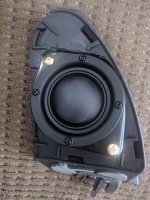 sOVasQsr.jpg366.6 KB · Views: 312
sOVasQsr.jpg366.6 KB · Views: 312 -
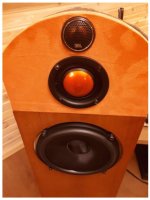 2021-02-03 01_21_19-jbl-stadium-gto-20m _ Студия а
.jpg91.4 KB · Views: 342
2021-02-03 01_21_19-jbl-stadium-gto-20m _ Студия а
.jpg91.4 KB · Views: 342 -
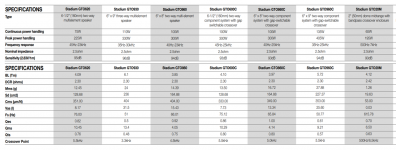 2021-02-03 01_43_31-TR04192_JBL Stadium Speaker_OM_Global_B_V13_LD.pdf.png215.2 KB · Views: 248
2021-02-03 01_43_31-TR04192_JBL Stadium Speaker_OM_Global_B_V13_LD.pdf.png215.2 KB · Views: 248 -
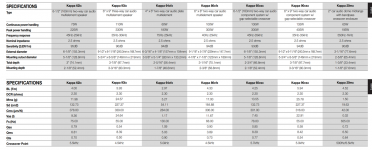 2021-02-03 01_43_09-TR04087_Infinity_Kappa_Speaker_OM_F_V8_BW_LD.pdf.png256.2 KB · Views: 207
2021-02-03 01_43_09-TR04087_Infinity_Kappa_Speaker_OM_F_V8_BW_LD.pdf.png256.2 KB · Views: 207
Last edited:
I somehow cannot understand the idea of using a closed back driver. Let's say I have a closed back midrange with resonant frequency of 450 Hz. Does that mean I am limited by this frequency on the low end crossover point or was the formula something like 0.707 * fs for the low crossover point?
If I wanted to make my own closed back midrange (out of FaitalPro 3FE22 8 ohm version) with 3D printing a custom back enclosure, for what Q and fs should i target the volume of the back enclosure ideally? My target for the low crossover point would be ca 300 Hz, the high crossover point as high as possible. Is that doable with this speaker?
Edit: Using the formulas at the beginning of the thread get me the following numbers 2fs/Qes = 423 Hz. I should calculate the volume to get a Qt of 0.707, which is around 1l. Am I correct?
If I wanted to make my own closed back midrange (out of FaitalPro 3FE22 8 ohm version) with 3D printing a custom back enclosure, for what Q and fs should i target the volume of the back enclosure ideally? My target for the low crossover point would be ca 300 Hz, the high crossover point as high as possible. Is that doable with this speaker?
Edit: Using the formulas at the beginning of the thread get me the following numbers 2fs/Qes = 423 Hz. I should calculate the volume to get a Qt of 0.707, which is around 1l. Am I correct?
Last edited:
- Home
- Loudspeakers
- Multi-Way
- Suitable midrange cone, for bandpass mid in Unity horn
